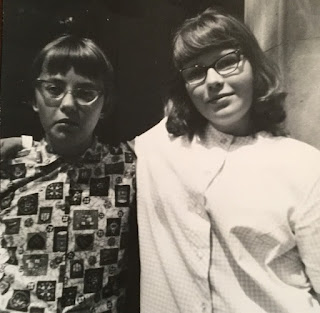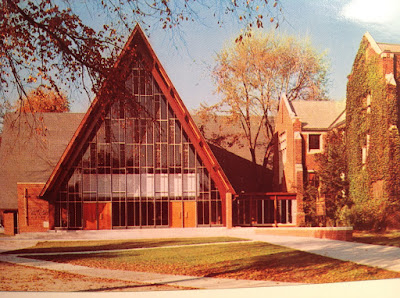My first year of school in Michigan came to an end. Summer was long and boring--no Day Camp at Herbert Hoover Junior High School, no kids gathering for games under the streetlights, no friends, no cousins seen regularly. While my little brother had lots of kids his age on our street, there were only a few my age and they were either a few years older or a few years younger. The lack of a shared history and mutual experiences made it hard to connect.
 |
| Dad and I shoveling snow |
I did still bike over to see Gail, even after my grandparents moved to another house a few miles away in Berkley.
 |
| Gail M. and Me |
I had cousins but they were all younger than me. My mother's sister and one of her brothers lived in Metro Detroit.
 |
| Me and my Ramer cousins. I am on the left and my brother is in blue. |
Seventh Grade meant a new school, Jane Addams Junior High, over a mile's walk away. We had to wait in lines outside the building for the doors to open. It was there I experienced bullying, albeit a mild sort.
I wore a Mod cap hat. There was a group of girls called "greasers," dressed in black leather coats and sporting dark eye liner and teased hair. One decided to take my hat and toss it. I got mad. So of course, she did it again the next day.
My teacher Mrs. Green liked outgoing kids and was concerned about my shyness. Even in elementary school my teachers would say I was "coming out of my shell," but with the move and school change I was even more shy. Mrs. Green told my parents there was something 'wrong' with me and Mom got pretty upset. Actually there was something 'wrong'; I was depressed and homesick for Tonawanda. In November I wrote, "I wish I could go back to Buffalo--I miss the street, the houses, the people, the friends."
I was lonely and made up a friend, Homer the Ghost, who kept me company on my long walks to school. I made up a whole ghost family. I knew he was imaginary. When others learned about Homer they were not so sure.
 |
| Homer the Ghost |
The school had Friday night Boy-Girl dances. I did not (would not) like rock and roll, I was a klutz and had no interest in dancing, and I did not like boys "that way." No, Friday nights were for
The Man From Uncle, and I was a card-carrying member of the fan club. I wrote about it
here.
A teacher asked who was going to BOGI, the boy girl dance; my hand stayed down. She decided to have a boy ask me to the dance. I was outraged. He was popular so I knew he could not really like me, the weird, uncool kid. Girls encouraged me to go, that he meant it, but I did not believe it. He tried again the next day, too. I never forgave or forgot that experience.
Later when that same boy learned about Homer he asked our art teacher if my ghost was real. She said, "Nancy's pulling the wool over your eyes." I didn't know what that even meant, but until graduation day that boy would ask me, "How's Homer?" with a knowing gleam in his eye.
 |
| Mom, me, Dad, and Tom |
What did change my life were the electives classes: a quarter year spent in sewing class, cooking class, art class, and music class.
 |
| Drawing exercise in Art Class |
My grandmother bought me a piano that year and my lessons resumed. I discovered I liked to sew and was good at art, and I was thrilled to be in chorus again. I drew a lot and kids asked for my pictures.
 |
| My horse drawings |
 |
| Imaginary friends |
Mr. Russell Henckel was our choir teacher. He was fun, but strict when the boys acted up. There was a paddle in his office and he was not afraid to use it. We listened to Gilbert and Sullivan's operetta
Iolanthe in class while the words were projected on a screen. One day we arrived in class to see projected a note: "Help! I'm being held prisoner in the projector!" The next day there was a picture of the captive. We also studied Mozart; I wrote that he had a sad life with only his dog at his funeral.
On November 20, 1964 I started to read
Jane Eyre and liked it. That fall I wrote my first poem, a very lousy poem called The Bat, and later one called The Poem.
On the anniversary of the assassination of President Kennedy I wrote,
"A year ago today, President John F. Kennedy was assassinated. I remember walking down the hall and passing a class watching a TV--an educational channel. They were the first to know. Mr. Saffronoff and our class went to the library. Everyone was in a daze, no one knew really what happened. Only that the President was assassinated. Mr. S talked to us about how the President was assassinated and about the president. We couldn't accept the fact at first. I was confused. We went back to our room --Mr. S left us for a minute. Some didn't believe it--thinking it was a hoax. Others said the killer must be insane. I felt very sad, depressed, as I walked home alone; I cried. I didn't know much about him--I wasn't interested in politics. When I got home I acted naturally and all after that, like it seemed it didn't matter."
There was a Mock Election held at school. I was still clueless about politics. I was asked if I would vote for LBJ or Barry Goldwater. Then I was told about LBJ's Great Society and war on poverty. I decided to vote democrat. It was one of the few winning votes I have ever cast.
On November 25 I read
The Lost Continent of MU, perhaps a book from my Grandfather Ramer, and
Stop the Typewriters! about an eleven-year-old girl named Nancy who wants to be a writer.
Over Christmas break, my family returned to Tonawanda. We left December 31. I wrote it was a sunny, muddy day. I wrote about seeing a Glendale street and recalled the song
442 Glendale Ave. My brother said the twin Grand Island Bridges belonged in Ripley's Believe It Or Not.
We stayed with my Aunt Alice's family, which now included Grandma Gochenour. I have no idea how they fit us all in! We visited all our old friends and I saw all my cousins ("they act and mainly look the same but, boy, they have grown" I wrote) and we stopped at the Kuhn's house.
I spent a day with Nancy Ensminger and we had our photos taken in a photo both. Her mom fed us canned spaghetti.
 |
| Me and Nancy Ensminger |
 |
| Nancy Ensminger, Christmas 1964 |
By spring I had made some friends, Dee and Diane, two girls whose families had moved from the South to Detroit for jobs. Dee and I just started talking on the long walk home from school. She lived a few blocks away. Diane lived next door to Dee.
I joined a Girl Scout troop, although I was disappointed the girls were more interested in watching
Hullabaloo on television and talking about boys than scouting. But I was thrilled with our 'adventures,' like this one I wrote about in my diary:
"We sold calendars at Hollywood grocery. Betty Sue and Besty went to Edward's but were kicked out. The manager said they were bothering the customers. They went to Frentz & Sons Hardware, who bought two, one to hang in the store. At the Funeral Home--Spiller-Splater? Or is it Spitter-Splatter? Or Spiller-Splitter? Well, anyways, Betty Sue started to go in but Betsy said they'd better ring the door bell. Four or five rings later a very mad man answered. He took Betty by the collar and asked what she wanted. "I want to sell you a Girl Scouts Calendar," she said calmly. "I don't want any," was his answer and he turned away. Halfway, he came back. "OK--how much?" Betty Sue said he just didn't want the funeral home to have a bad reputation. At Rambler and Pontiac Betsy told a man that her brother bought a car from there and if he didn't buy a calendar he'd return it. "Get lost," was his affable answer. At Pontiac they were real nice and gave them some booklets, too. Lynn, Cherie, Cindy and me and Mrs. D stood at the entrance of Hollywood. One man said he'd buy one when he came out. We were there three hours and he never came back out! Another man answered no, but don't tell his wife he had a Playboy one already. A boy who worked there we asked every time he came by. Once, we didn't ask him and he looked surprised."
Already I was recording the life around me in detail.
I was invited to visit a church and saw an altar call. I saw people whose belief in God was so real they were crying. It made me consider issues of faith for the first time, and I committed to developing a believe in God.
My Grandfather Ramer took me with him to St. John's Episcopal Church. Having grown up in the Broad Street Baptist Church in Tonawanda, with it's immersion Baptism and stained glass windows, being Episcopal was an adjustment. We genuflected, knelt, had responsive readings, plus the church was modern and huge. I had several schoolmates in the confirmation class, plus my friend Gail's family were members. My first communion I sipped from the Communion cup as instructed. I hated the sour wine and I learned to dip my wafer into the wine!
 |
| St John's Episcopal Church, Royal Oak MI in the 1960s |
I made friends in the neighborhood, including a boy named Mike D., a year younger than me. Mike and I took Dad's telescope into the back yard and looked at the moon and stars, making up stories about outer space. We enjoyed pretending stories about Homer the Ghost.
 |
| My imaginary gang, Homer the Ghost and friends |
One day his younger sister asked if I would like her brother to be my boyfriend. I was upset. First, because I valued friendship above everything and had no interest in boys, and because, actually, I had a crush on him, too, but was not about to admit it. I alienated a friend, and then he and his siblings moved away. I was heart broken, having lost a true kindred spirit friend. But nobody knew.
I still listened to CKLW on the radio in bed at nights. In the spring of Seventh Grade I heard
Stop! In the Name of Love by the Supremes. I liked it.
It was the beginning of the end of childhood. I liked a boy and I liked a rock and roll song. My long-held promise to my Grandmother Gochenour was being broken, for I was unable to be Peter Pan and avoid growing up.
 |
| Here I am at the end of Seventh Grade |
 Michael Heyns' knowledge of Henry James is evident in The Typewriter's Tale. It is not biographical historical fiction as much as fiction inspired by The Master.
Michael Heyns' knowledge of Henry James is evident in The Typewriter's Tale. It is not biographical historical fiction as much as fiction inspired by The Master.

















































































